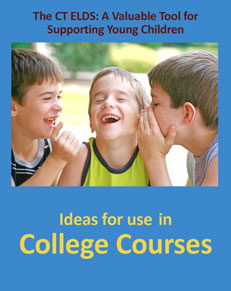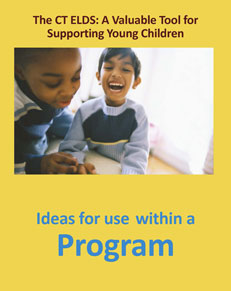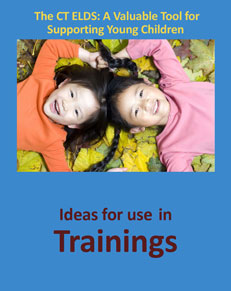The CT ELDS: A Valuable Tool for Supporting Young Children
(This video has captions. You can turn them on by clicking the CC icon at the bottom of the video.)
Download a printable English transcript or Spanish transcript.
Narrator: Early care and education providers are continually striving to provide developmentally appropriate experiences for young children. This requires the ability to explore topics that are well-matched to children’s interests, engage in interactions that are a good fit with their current levels of development, and challenge children to move toward higher levels of thinking or ability without overwhelming them. The Connecticut Early Learning and Development Standards are a great tool to guide this work.
The Connecticut ELDS were designed to provide common language about early learning and development so that families, communities and schools can work together to support young children across settings.
Michelle Levy, Education Consultant, Connecticut Office of Early Childhood: Early learning and development standards articulate what we want children to know and be able to do, and are really a reflection of child development. Young children go through many phases and stages as they learn to become engaged students and learners.
Narrator: The ELDS are organized across eight domains and include learning progressions for children from birth to age 5. Most early care and education providers will recognize skills, dispositions, and knowledge that they are already supporting.
Maureen Ostroff, Preschool Teacher, CES School Readiness: When I first gave it to my assistant teachers and showed them this they were like, “Oh my goodness these are so many things this is so complicated,” but we sat down and we actually read through them and realized these are all things we are already doing in the classroom.
Jacqueline Holmes, Infant Teacher, Women’s League Child Development Center: It seems a little difficult, but actually, when you just really read it and understand it, it’s not that hard.
Narrator: While learning to use this tool may take some time, it offers an opportunity to learn more about different areas of development and learning and to think deeply about how we support young children.
The CT ELDS: A Critical Component of Intentional Teaching (2:07)
Narrator: The ELDS is a useful tool to guide an understanding of common learning progressions.
Cathy Tormey, Family Child Care Provider, Cathy Cares: Kids do not come with a manual, and so that’s like the closest thing to a manual for certain things you can get. I think it’s a great starting point for people to get familiar with what to expect.
Narrator: Additionally, it is crucial to consider what is known about each child’s unique abilities and needs.
Jennifer Wolff, Preschool Teacher, Cook Hill Integrated Preschool: One of the important things in my classroom is to work on assessment of the children to gain an understanding of where they currently are and so we use a separate assessment tool. And using that data we can then come back to the ELDS and gain an understanding of how to continue to scaffold that child’s development to get them to the next level and to keep going in their development.
Karen DelMastro, Preschool Teacher, Windham Early Childhood Center: You figure out what materials, what activities will help to move that child from where they are now, up and keep moving them up. So it’s important to figure out where they are and where they need to go.
Narrator: The ELDS helps providers engage in an ongoing cycle of intentional teaching.
Michelle Levy: We’re always thinking about what we want children to know and be able to do, the ways we figure out where they are, and the supports we provide to help them move to the next step.
Narrator: The ELDS includes important principles related to how children grow and learn as well as the different roles and responsibilities of families, communities and early learning environments.
Features of the CT ELDS (3:46)
Narrator: Providers are finding several features of this tool to be especially useful in their work with young children.
Features: Birth to Five Age Span (3:53)
Janette Rivera, Infant/Toddler Teacher, Windham Early Head Start: I think having the Connecticut ELDS for infants to five is great. Some of our kids in our program are already mastered a lot of the things at their age level so now it’s thinking about, where should they be; what’s the next step; what else can we do to support their learning? And having that to guide us is very important.
Ashley Anderson, Preschool Teacher, Plainfield Head Start: It’s nice to sort of see the whole span. I like that you can really follow a child now from birth, especially in Head Start, where we have Early Head Start, so a lot of times the children are coming to us having come from a program that is linked to ours and so now we can follow children literally from birth all the way up to five.
Jennifer Wolff: The standards in the ELDS connect very well to the Common Core Standards so when transitioning them to kindergarten, and onwards you can continue to use those and develop goals from there.
Suzanne Slater, Kindergarten Teacher, Natchaug Elementary School: The Early Learning Development Standards are a good focus for the beginning of kindergarten. It goes up to age five; I still have kids that are four.
Suzanne: Alright, remember to put the date and your name on your play plan when you’re deciding what to play.
Features: Build on Research (5:04)
Narrator: The CT ELDS are based on the latest research in child development. For example: The domain of cognition includes a strand that addresses executive function. This refers to a set of abilities that include children’s self-regulation of attention and behavior, as well as their ability to plan and persist when things are challenging.
Niloufar Rezai, Program Director, Child and Family Development Resource Center: It’s an area that we may have overlooked as educators. Teachers now are aware so they’re able to guide children towards achieving those goals.
Ashley Anderson: If a child is losing interest in the block area, encouraging them to extend their learning, extend their play.
Ashley: I wonder if you could do something other than crash into the end. I notice the cylinder keeps rolling away. What else could you do?
Features: Connect to Kindergarten Content Areas (5:57)
Narrator: While the ELDS can help providers think more deeply about the skills that young children are capable of, they also emphasize content that is worth knowing.
Amy Figueroa, Preschool Teacher, Women’s League Child Development Center: It’s really specific, the ELDS gives you more of a deeper look into math, its own section so that’s great.
Maureen Ostroff: The Science, not just cause and effect science inquiry, but learning about nature, and our environment and the social studies piece; learning about our neighborhood. Those are things that you should be teaching in a well-rounded curriculum.
Child: Whipped cream.
Maureen: Whipped cream cookies? They’re very delicious.
Amie Theriault, Toddler Teacher, Child and Family Development Resource Center: Being a toddler teacher, it may not be appropriate for me to bring in a map and talk about what people in Asia are doing, or that sort of thing. But I can talk to the children about their families, about their world, about what they know.
Amie: We have snow at our school, don’t we? And do you have snow at your house?
The CT ELDS in Practice (6:53)
Ashley Anderson: How I use it in my classroom; to be able to make sure that the materials are developmentally appropriate for where the children are, and what their needs are for their learning to occur.
Jennifer Wolff: So we choose 2 or 3 standards from different areas of the ELDS and each week we try to target those standards so that we create centers and activities based on those standards.
Patricia Gardner, Preschool Teacher, Child and Family Development Resource Center: I think it’s important when you do any kind of investigation to get a child’s perspective on something. Children come to school with a lot of different experiences and we look to where the children are most interested, if they’re most excited about something. We come up with a list of standards that we need to focus on and then we generate a list of activities. So those are all things that come into play when we pick a topic.
Janette Rivera: Using standards helps me plan for the child depending on their age, on their development. For example, to help children develop social relationships; getting infants and toddlers to play together with the same activities, the same toys.
Yotisse Williams, Preschool Teacher, HCC Early Childhood Laboratory School: It’s really the driving force, what activities we use. We were counting, so I incorporate that in music so we’re counting the beats; how many turns we can get. Group time we’re doing show me with your fingers.
Yotisse: That’s interesting. You said three and three, so let’s count.
My personal strategy is to use it throughout the day, throughout the room, in all different areas. They talk a lot about being an intentional teacher. I think if you have that mentality you are being very intentional.
Meeting Diverse Needs (8:37)
Narrator: The Early Learning and Development Standards serve as a foundation for supporting all young children. Age bands are included for reference; however, providers must be responsive to the diverse needs of individual children.
Karen DelMastro: It follows along, you start over here and the children move up. And some children are not maybe where you would expect them to be for that age so you step back and look if this is where they are at this this point in time, this is where you’re teaching. You’re going to move them from where they are, just up a little bit at a time.
Cathy Tormey: Some kids are just going to be more active, they’re just going to be more musical, you know, they’re all different. That’s what makes them unique, you know, and fun.
Child: It smells good.
Cathy: What does it smell like?
Child: Waffles.
Jennifer Wolff: The ELDs is particularly useful for my students with special needs because I’m able to use the standards and modify those to utilize as their IEP goals. It’s developmentally appropriate for them and it meets the same criteria that the other students in the classroom are working on so that we can work on the same goals all together and I can help those children to achieve it from the area that they are and help them to progress from there.
Narrator: The ELDS can also support children from diverse cultural and linguistic backgrounds.
Narrator: The tool’s Dual Language Development Framework helps providers consider the unique needs of children who are learning more than one language.
Karen DelMastro: We do support children’s primary language. We talk with parents about that and tell them it is important for children to continue in their home language.
Working with Families (10:31)
Narrator: The ELDS and the accompanying Action Guides can assist families in understanding their own children’s learning and development.
Cathy Tormey: I do like the Action Guides. I think they’re great for parents, especially first time parents. And I like the simplicity.
Narrator: Early childhood professionals can use this as a tool for discussing common learning progressions and behaviors with families.
Jennifer Wolff: Here are some ways that you can assist your child at home and we’re doing the same strategies at school so that we can work as a team.
Ashley Anderson: I feel like it’s much easier to explain the ELDS to parents and to be able to show it to them at conferences. And it makes more sense, it’s more comprehensive than anything we’ve used in the past. And I actually keep it on my family resource shelf so that it’s accessible to them.
Narrator: Many early care and education providers are intentionally utilizing the ELDS in meaningful ways to benefit the children and families they serve. The Connecticut Early Learning and Development Standards help us to ensure that all children regardless of background, age, or ability receive the care and education they need to become competent, caring, and healthy.






